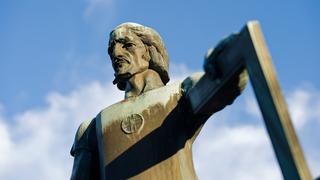10 Facts about St. Joseph in Honor of his Feast Day
In honor of the Feast of St. Joseph, we’re sharing 10 facts you may not know about the University's namesake.
 A statue of St. Joseph the Worker stands in front of Barbelin Hall.
A statue of St. Joseph the Worker stands in front of Barbelin Hall.
On March 19, Saint Joseph’s University celebrates the Feast of St. Joseph, honoring the namesake of the University. Since the 10th century, this date has been observed as the principal feast day of St. Joseph in Western Christianity and commemorates the life of Joseph. The husband of Mary and earthly father of Jesus, Joseph is often referred to as the father in the shadows. In fact, none of Joseph’s words are written in the gospels and little was recorded about his life. In honor of the Feast of St. Joseph, we’re sharing 10 facts you may not know about the University's namesake.
10 Facts About St. Joseph
-
In 1955, an additional feast day was declared by Pope Pius XII and is celebrated on May 1 as the Feast of St. Joseph the Worker. This date is also International Workers’ Day and believed to reflect Joseph as the patron saint of workers. The statue in front of Barbelin Hall of St. Joseph the Worker was donated by students of The Evening School who studied in the evenings after work.
-
Symbols associated with Joseph include the carpenter's square and lily. The carpenter’s square not only symbolizes Joseph’s trade but also the concept of truth. The lily, which can also be seen in the Saint Joseph’s University logo over the letter J, represents purity and Joseph’s celibate marriage to the Virgin Mary.
-
Joseph is the patron saint of the Universal Church, families, fathers, expectant mothers, travelers, immigrants, house sellers and buyers, craftsmen, engineers and working people, among others. In the grotto behind the Chapel of Saint Joseph stands a statue of St. Joseph the Dreamer. Serving as a space for personal retreat, prayer and reflection, the grotto features a light that is always on.
-
Joseph is also considered to be the patron saint of the New World, China, Canada, Korea, Mexico, Austria, Belgium, Croatia, Peru, Vietnam and several cities and dioceses. Inside the Chapel of Saint Joseph is an image of a sleeping St. Joseph, a weary traveler fleeing with his family to Egypt – and a replica of one Pope Francis keeps in his room. The pope places notes of special intercession on pieces of paper under the statue. Visitors to the chapel can do the same, placing their intentions under the statue, asking the fatherly saint to intercede to God for a special need.
-
On the 150th anniversary of the declaration of St. Joseph as Patron of the Universal Church, Pope Francis proclaimed a Year of St. Joseph beginning Dec. 8, 2020 through Dec. 8, 2021. In an opinion column for The Philadelphia Inquirer, Daniel Joyce, S.J. ’88, executive director of mission programs, described the pope’s official opening of a yearlong celebration as “a global call for solidarity and a renewed way of being family in the post-pandemic world.”
-
Although we know Joseph as a working carpenter, he is descended from royal lineage, the line of David.
-
Joseph is portrayed in works of art with grey hair and a beard, an older figure next to Mary and Jesus, and often in the background. In the pope’s Apostolic Letter entitled Patris Corde, he wrote, “In his relationship to Jesus, Joseph was the earthly shadow of the heavenly Father. He watched over him and protected him, never leaving him to go his own way. We can think of Moses’ words to Israel: ‘In the wilderness … you saw how the Lord your God carried you, just as one carries a child, all the way that you traveled’ (Deuteronomy 1:31). In a similar way, Joseph acted as a father for his whole life.”
-
The scriptures mention nothing of Joseph’s age and previous life. However, one early tradition believes he was an older man and a widower with children from a previous marriage.
-
The first apostolic mission entrusted by the Pope to the Society of Jesus was given on the Feast of St. Joseph, Mar. 19, 1539. On this auspicious feast day, the mission of the Jesuits began – and continues to this day around the world.
-
The Jesuits began their mission in Philadelphia in 1707, saying regular Masses under the patronage of St. Joseph in Quaker-owned boarding houses and shops, and the homes of Catholic families. This led to the establishment in 1733 of Old Saint Joseph’s Church, the first permanent Jesuit ministry in the city.
